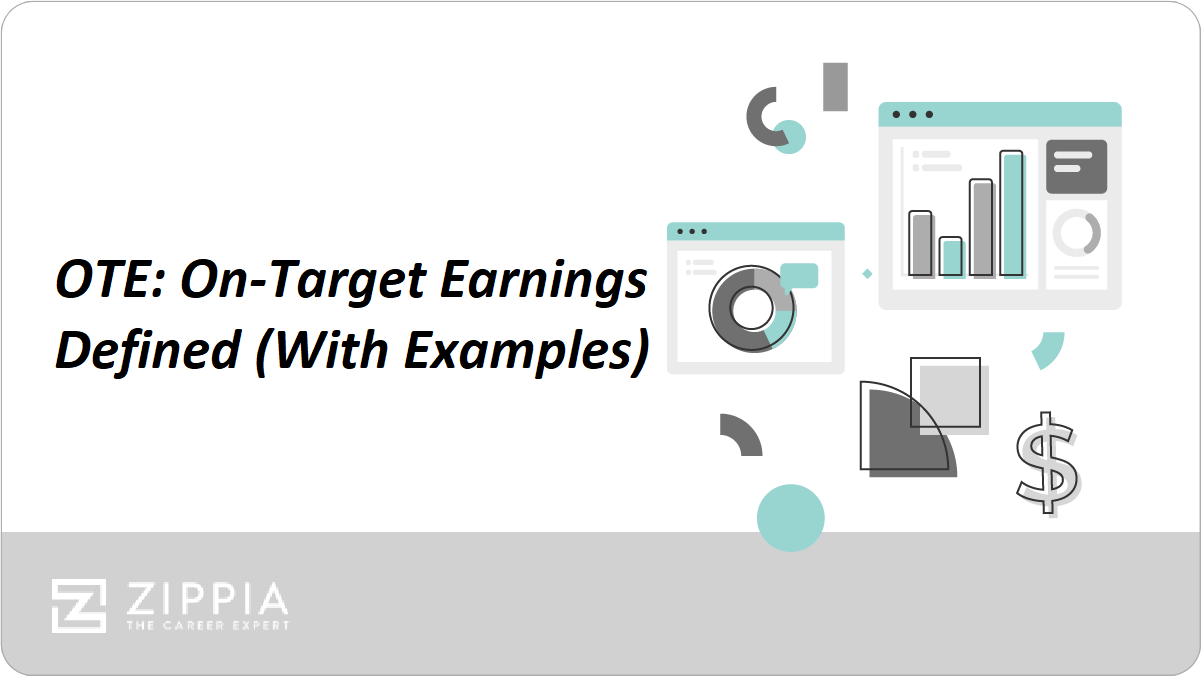Summary. On-target earnings (OTE) is a metric that predicts how much an employee will earn in a year if they meet all of their performance targets. OTE typically includes things like salary, commissions, and bonuses. This term is most common in sales-based professions where an employee’s pay comes from commission.
Setting salaries can be difficult enough normally, but when performance-based commissions and bonuses get involved, it gets that much more complicated.
To help with this, companies that offer performance-based pay usually calculate OTE, or on-target earnings, to let their salespeople and managers know how much they’ll earn if they accomplish their sales goals.
In this article, you’ll learn more about OTE and how to calculate it for your employees.
Key Takeaways:
-
OTE includes employees’ base salaries as well as the commissions and bonuses they’ll earn if they hit their performance goals.
-
OTE is commonly used in sales and management positions.
-
Companies have different philosophies and rules surrounding what OTE represents as far as a guarantee of how much employees will make.

What Is OTE?
OTE is a metric that predicts how much an employee will earn in a year if they meet all of their performance targets.
OTE stands for on-target or on-track earnings, and it usually includes:
-
Salary
-
Commissions
-
Bonuses
This term is most common in sales-based professions where much of employees’ pay comes from commission, but it’s also commonly used for management roles that offer significant pay fluctuations or bonuses based on the manager’s performance.
Employees in these roles rely on their OTE to know approximately how much they’re going to make, so if your company is hiring in any of these areas, you’ll need to calculate the positions’ OTE.
How to Calculate OTE
When you’re calculating OTE for a current employee or a job description, here are the steps you need to follow:
-
Determine the base salary. You need to know the base pay that the employee will be guaranteed no matter how they perform. If your organization doesn’t already have a set rate for this, talk with your financial and HR team to determine fair compensation for the employee’s presence and work that doesn’t necessarily involve making sales.
-
Decide on performance targets. These are usually sales quotas, whether for individual salespeople or a manager’s branch or team.
Unless you’re using OTE as a stretch goal, make sure these targets are reasonable and seem attainable to employees and job candidates: Otherwise, they won’t be motivated to even try to win what they see as a losing game.
-
Attach a monetary value to those performance targets. In other words, how much commission or bonus pay can an employee earn for each performance goal they meet?
This will likely vary based on the role and how difficult the targets are to achieve based on the complexity of the sales process, how established your company is, and how competitive the industry is. It can also be a percentage – as it often is for a sales commission – or a fixed number – as it often is for a bonus.
-
Add the base salary and the performance target compensation together. This is your final step in calculating OTE, and it is the number that you can list on the job description or in the job offer.
-
Make sure it makes sense. As with any math problem, stop and make sure your OTE makes sense. Is it comparable to your current employees? Does it make sense with the market’s average salary?
Always have someone else trustworthy check it before you finalize the OTE. You don’t want to make it too low and not attract any candidates or too high and not be able to fulfill it once you hire someone.
Additional Tips for Calculating OTE
-
Determine your company’s OTE philosophy. Different companies have different views on what OTE means, so your organization needs to decide what it means for your employees. Here are a few of the common schools of thought around OTE:
-
OTE is the minimum requirement for your employee, and if they don’t hit the performance targets that correspond to the OTE, they’ll be fired.
-
OTE is the typical take-home pay that the average salesperson at your company earns and is based on the market, cost of living, and reasonable sales goals. It also may be higher or lower than a particular employee actually earns, depending on how they perform.
-
OTE represents the maximum amount of money that employees could earn if they sell especially well, but the majority won’t because those performance targets are stretch goals.
-
-
Establish an OTE cap if you choose to set one. One of the most common questions you’re going to get from a job candidate is if they can exceed their OTE and by how much. However you decide to answer this, you just need to make sure it’s consistent with the rest of your current and future employees.
-
Balance realism with enticement. Some companies may base the OTE they put in a job offer on the candidate’s past earnings. While this is a good way to make sure you aren’t paying them more than you have to, it doesn’t necessarily do much to convince them to come work for you.
Add a little extra to sweeten the pot and motivate them, but not so much that you have to lower it once they start working. This would be unethical, and your employees aren’t likely to stay long if you do this.
-
Remember that your salespeople have other work responsibilities. Your sales representatives are going to have non-sales work that they need to do, and you need to pay them for, so include that in the salary part of your OTE calculations as well.
OTE FAQ
-
What does OTE mean?
OTE means on-track or on-target earnings. It’s a metric used to determine how much a salesperson can earn in a year if they hit their sales goals.
OTE includes the salesperson’s base salary and any commissions or bonuses that they can earn if they meet set performance targets. Companies put this number on job descriptions or job offers to let candidates know how much they’ll likely earn in a particular position.
OTE is most often used in sales-based positions, but managers can have OTEs that include bonuses they can earn based on how well their team or branch location performs.
Depending on the company, an OTE may be a guaranteed amount the employee will earn if they’re doing their job at all, an estimate of the average pay they’ll earn if they work hard, or a maximum amount they can earn based on performance targets that few actually reach.
-
Is OTE on top of salary?
No, OTE isn’t on top of salary. OTE includes the base salary, commissions, and bonuses that an employee can earn. Many sales positions will list the OTE on the job description or job offer to give candidates an idea of how much they’ll be making, as it’s an estimate of the total amount of money they can earn for the year.
While OTE does usually include any salary adjustments that come from working second or third shifts, it generally doesn’t include any overtime pay that employees may be able to earn.
To attract, keep, and motivate employees, companies need to set an OTE that creates a competitive overall take-home pay and feels doable to workers.
-
What does 75k OTE mean?
75k OTE means employees will make about $75,000 total if they hit all of their performance targets that year. OTE stands for on-track or on-target earnings, and it includes employees’ salaries and any commissions or bonuses they will likely earn during the year by reaching performance goals.
While this is the way OTEs work for most companies, some see this number as the minimum amount employees will earn, as they’ll be fired if they don’t reach the sales targets that will earn them that amount of money in commissions.
Others see it as the maximum amount that you could earn if you do an amazing job, although few employees will actually earn that much.
Because there are so many different philosophies, companies need to establish what OTE is to them so they can be consistent for all of their current and new hires.





